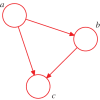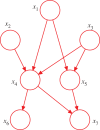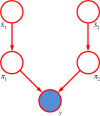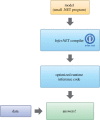Model-based machine learning
- PMID: 23277612
- PMCID: PMC3538442
- DOI: 10.1098/rsta.2012.0222
Model-based machine learning
Abstract
Several decades of research in the field of machine learning have resulted in a multitude of different algorithms for solving a broad range of problems. To tackle a new application, a researcher typically tries to map their problem onto one of these existing methods, often influenced by their familiarity with specific algorithms and by the availability of corresponding software implementations. In this study, we describe an alternative methodology for applying machine learning, in which a bespoke solution is formulated for each new application. The solution is expressed through a compact modelling language, and the corresponding custom machine learning code is then generated automatically. This model-based approach offers several major advantages, including the opportunity to create highly tailored models for specific scenarios, as well as rapid prototyping and comparison of a range of alternative models. Furthermore, newcomers to the field of machine learning do not have to learn about the huge range of traditional methods, but instead can focus their attention on understanding a single modelling environment. In this study, we show how probabilistic graphical models, coupled with efficient inference algorithms, provide a very flexible foundation for model-based machine learning, and we outline a large-scale commercial application of this framework involving tens of millions of users. We also describe the concept of probabilistic programming as a powerful software environment for model-based machine learning, and we discuss a specific probabilistic programming language called Infer.NET, which has been widely used in practical applications.
Figures













Similar articles
-
AZOrange - High performance open source machine learning for QSAR modeling in a graphical programming environment.J Cheminform. 2011 Jul 28;3:28. doi: 10.1186/1758-2946-3-28. J Cheminform. 2011. PMID: 21798025 Free PMC article.
-
Designing and Evaluating the Usability of a Machine Learning API for Rapid Prototyping Music Technology.Front Artif Intell. 2020 Apr 3;3:13. doi: 10.3389/frai.2020.00013. eCollection 2020. Front Artif Intell. 2020. PMID: 33733132 Free PMC article.
-
The future of Cochrane Neonatal.Early Hum Dev. 2020 Nov;150:105191. doi: 10.1016/j.earlhumdev.2020.105191. Epub 2020 Sep 12. Early Hum Dev. 2020. PMID: 33036834
-
Data-driven modeling and prediction of blood glucose dynamics: Machine learning applications in type 1 diabetes.Artif Intell Med. 2019 Jul;98:109-134. doi: 10.1016/j.artmed.2019.07.007. Epub 2019 Jul 26. Artif Intell Med. 2019. PMID: 31383477 Review.
-
Machine learning methods without tears: a primer for ecologists.Q Rev Biol. 2008 Jun;83(2):171-93. doi: 10.1086/587826. Q Rev Biol. 2008. PMID: 18605534 Review.
Cited by
-
Decoding Drug Discovery: Exploring A-to-Z In Silico Methods for Beginners.Appl Biochem Biotechnol. 2025 Mar;197(3):1453-1503. doi: 10.1007/s12010-024-05110-2. Epub 2024 Dec 4. Appl Biochem Biotechnol. 2025. PMID: 39630336 Review.
-
Machine learning to detect signatures of disease in liquid biopsies - a user's guide.Lab Chip. 2018 Jan 30;18(3):395-405. doi: 10.1039/c7lc00955k. Lab Chip. 2018. PMID: 29192299 Free PMC article. Review.
-
Atopic Dermatitis and Respiratory Allergy: What is the Link.Curr Dermatol Rep. 2015;4(4):221-227. doi: 10.1007/s13671-015-0121-6. Epub 2015 Sep 28. Curr Dermatol Rep. 2015. PMID: 26566461 Free PMC article. Review.
-
Smartphone as a Sensor in mHealth: Narrative Overview, SWOT Analysis, and Proposal of Mobile Biomarkers.Sensors (Basel). 2025 Jun 11;25(12):3655. doi: 10.3390/s25123655. Sensors (Basel). 2025. PMID: 40573543 Free PMC article. Review.
-
Docking-generated multiple ligand poses for bootstrapping bioactivity classifying Machine Learning: Repurposing covalent inhibitors for COVID-19-related TMPRSS2 as case study.Comput Struct Biotechnol J. 2021;19:4790-4824. doi: 10.1016/j.csbj.2021.08.023. Epub 2021 Aug 19. Comput Struct Biotechnol J. 2021. PMID: 34426763 Free PMC article.
References
-
- Bishop CM. 2005. Pattern recognition and machine learning. Berlin, Germany: Springer
-
- Shotton J, Fitzgibbon A, Cook M, Sharp T, Finocchio M, Moore R, Kipman A, Blake A. 2011. Real-time human pose recognition in parts a single depth image. In IEEE Int. Conf. Computer Vision and Pattern Recognition, Barcelona, Spain, November 2011, pp. 415–422 IEEE
-
- Pearl J. 1988. Probabilistic reasoning in intelligent systems. San Francisco, CA: Morgan Kaufmann
-
- Koller D, Friedman N. 2009. Probabilistic graphical models: principles and techniques. Cambridge, MA: MIT Press
-
- Rabiner LR. 1989. A tutorial on hidden Markov models and selected applications in speech recognition. Proc. IEEE 77, 257–28510.1109/5.18626 (doi:10.1109/5.18626) - DOI - DOI
LinkOut - more resources
Full Text Sources
Other Literature Sources

